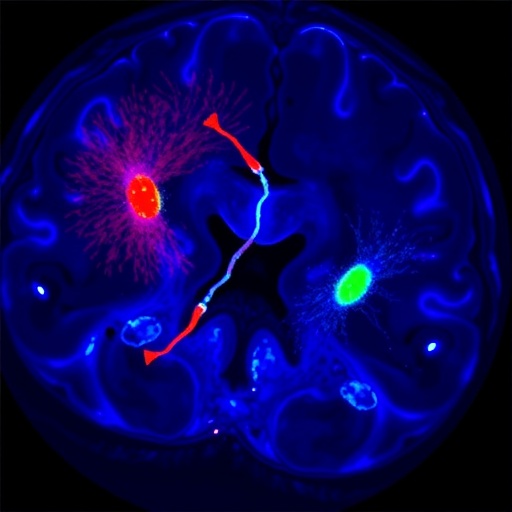In a compelling advancement in neuro-oncology, researchers from the University of Cologne have uncovered critical insights into the molecular mechanisms underlying glioma progression through their recent study on the LRIG protein family. Published in the oncology-focused journal Oncotarget on November 6, 2025, the study titled “LRIG1-3 in gliomas: LRIG1 protein expression decreased in higher grade gliomas” presents a nuanced exploration of LRIG1, LRIG2, and LRIG3 proteins and their varying expressions across glioma grades. These proteins are increasingly being recognized for their role in modulating cellular growth signals that influence tumor development and progression.
Gliomas represent the most prevalent form of malignant brain tumors among adults, frequently associated with dismal prognoses, especially in aggressive forms like glioblastoma multiforme (GBM). The heterogeneity of gliomas demands refined biomarkers to aid diagnosis, prognosis, and therapeutic strategies. This context prompted Marlene Happe and colleagues to dissect the expression patterns of LRIG protein members and interpret their relevance in tumor biology. Their findings illuminate the potential tumor-suppressive role of LRIG1 and its declining expression correlating with advancing malignancy, offering promising avenues for targeted therapies.
Crucially, the team demonstrated that LRIG1 protein levels are markedly reduced in higher-grade gliomas when compared to control and low-grade tumor tissues. Low-grade gliomas exhibited substantially higher LRIG1 expression, whereas high-grade tumors—particularly primary GBMs—showed the lowest protein abundance. Such gradation in LRIG1 suggests its function as a brake against tumor aggressiveness, where diminishing levels might facilitate unchecked cellular proliferation. Remarkably, secondary GBMs, which evolve from lower-grade gliomas, maintained relatively higher LRIG1 expression than primary GBMs, potentially contributing to variations in clinical outcomes between these tumor subsets.
Mechanistically, LRIG1 is implicated in negative regulation of receptor tyrosine kinases, pivotal modulators of cellular proliferation and survival signaling cascades. Its reduced expression in advanced gliomas may lead to hyperactive growth factor pathways, exacerbating malignancy. Western blotting and PCR analyses conducted by the researchers confirmed the inverse relationship between LRIG1 levels and tumor grade at both protein and mRNA transcriptional levels, underscoring a consistent pattern of downregulation as tumors become more hostile.
In stark contrast, LRIG2 displayed a more intricate expression profile. While gene expression data indicated higher LRIG2 mRNA levels in lower-grade gliomas, the corresponding protein levels paradoxically increased in more malignant tumors. This discordance between transcript and protein abundance hints at complex post-transcriptional or post-translational regulatory mechanisms modulating LRIG2 protein synthesis or stability. Understanding these layers of regulation is critical, as LRIG2 has been suspected to facilitate tumor progression, in opposition to the suppressive function of LRIG1, revealing heterogeneous roles within the LRIG family.
LRIG3 expression patterns add another layer of complexity. The protein was found to be upregulated in glioma tissues compared to normal brain tissue, with the highest levels detected in low-grade tumors. Intriguingly, LRIG3 expression did not significantly fluctuate with chemotherapy, suggesting resistance to treatment-induced modulation or a stable expression profile irrespective of therapy. This stability across treatment regimens may impact its utility as a biomarker or therapeutic target and requires additional study to elucidate LRIG3’s function in glioma biology.
The comprehensive analysis of these three LRIG family members by Happe et al. emphasizes their differential expression as critical molecular signatures distinguishing glioma grades. By integrating protein quantification and mRNA transcript evaluations, the study offers robust evidence for the inverse association of LRIG1 with glioma severity and reveals the nuanced, potentially dichotomous roles of LRIG2 and LRIG3. Such findings advocate for expanding LRIG-focused research, which could revolutionize glioma diagnostics and therapeutics through biomarker development or targeted molecular interventions.
Furthermore, the dissociation observed between LRIG2 mRNA and protein levels suggests the involvement of regulatory mechanisms such as microRNA interference, alternative splicing, or proteasomal degradation selectively impacting protein abundance. Deciphering these regulatory layers could unveil novel therapeutic vulnerabilities in glioma cells that exploit the unique expression dynamics of LRIG proteins. The study also highlights the importance of correlating transcriptomic data with proteomic outcomes to garner a comprehensive understanding of tumor biology.
Despite the significance of the LRIG proteins in glioma pathology, the study notes that chemotherapy had limited impact on their expression profiles. This observation suggests that conventional therapies may not exert pressure on these molecular targets or that tumor cells maintain LRIG levels through compensatory mechanisms. Such resistance highlights the need for alternative strategies that directly modulate LRIG activity or expression to restrain tumor progression.
Notably, by stratifying gliomas according to WHO grades and tumor subtype—primary versus secondary GBMs—the researchers provide a nuanced view of the molecular heterogeneity within these tumors. This stratification is vital for tailoring precision medicine approaches, potentially allowing clinicians to use LRIG1 expression levels as a prognostic indicator or to select patients likely to benefit from LRIG-targeted therapies.
The study’s findings also open intriguing questions about the functional interplay between the LRIG family proteins. The tumor-suppressive actions of LRIG1 and LRIG3 contrasted with the tumor-promoting tendencies of LRIG2 point toward a finely tuned regulatory network balancing growth signaling in glioma cells. Untangling these interrelationships could yield insights into glioma pathogenesis and pinpoint combination strategies for simultaneous modulation of multiple LRIG proteins.
In summary, this investigation elevates the LRIG proteins—especially LRIG1—to prominence as vital molecular markers with therapeutic potential in glioma management. The strong negative correlation between LRIG1 protein levels and tumor grade underscores its candidacy as a biomarker to improve diagnostic accuracy and refine prognostication. Moreover, the differential expression profiles of LRIG2 and LRIG3 invite further functional and mechanistic studies to fully exploit the LRIG family in combating malignant gliomas.
With gliomas remaining formidable challenges in neuro-oncology, this research charts a promising path forward. It paves the way for developing LRIG-targeted diagnostic assays and therapeutic agents, potentially improving outcomes for patients afflicted with these devastating brain tumors. As investigations continue, elucidating the roles and regulation of LRIG proteins may transform the clinical landscape of glioma treatment and enhance personalized care in this critical field.
Subject of Research: Not applicable
Article Title: LRIG1-3 in gliomas: LRIG1 protein expression decreased in higher grade gliomas
News Publication Date: 6-Nov-2025
Web References: http://dx.doi.org/10.18632/oncotarget.28775
Image Credits: Copyright © 2025 Happe et al. This is an open access article distributed under the terms of the Creative Commons Attribution License (CC BY 4.0), allowing unrestricted use, distribution, and reproduction in any medium with credit to the original authors.
Keywords: cancer, oncology, glioma, glioblastoma, LRIG1, LRIG2, LRIG3
Tags: aggressive glioma biomarkersglioblastoma multiforme researchglioma diagnosis and prognosisglioma grade correlation with LRIG1LRIG protein family in neuro-oncologyLRIG1 expression in gliomasmolecular mechanisms of glioma progressionneuro-oncology advancementsprotein expression in brain tumorstargeted therapies for gliomastumor-suppressive role of LRIG1University of Cologne glioma study





